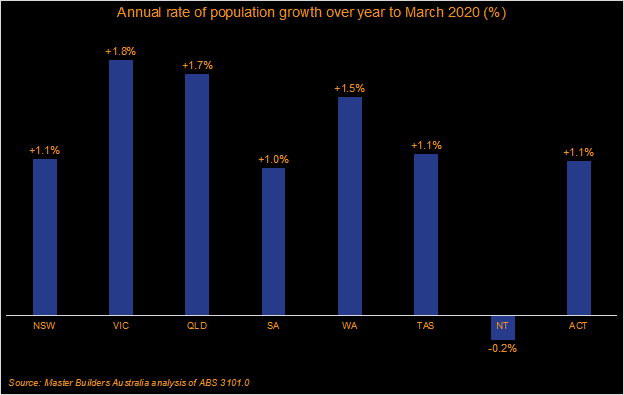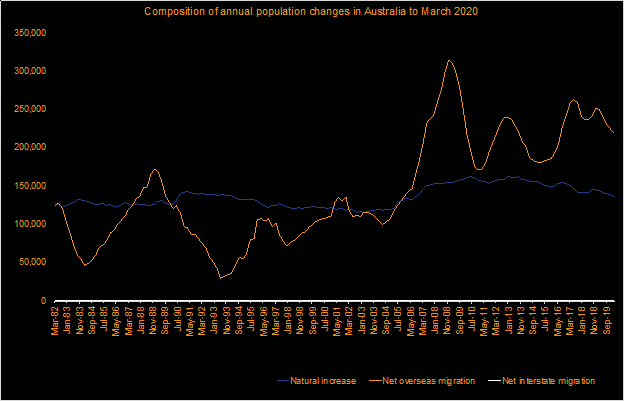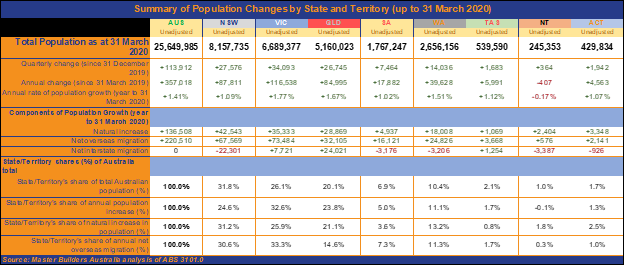- No products in the cart.
Master Builders Chief Economist Shane Garrett gives us some insight into the latest population figures and what they mean for future housing demand.
Population, Covid-19 and future building activity
Latest ABS data indicate that Australia’s population increased by 1.4% over the year to March 2020, equivalent to 357,000 more people in Australia.
- This represents a slight slowing in the pace of population gain.
- Net overseas migration (NOM) accounted for the majority of the population increase (+220,510).
- The excess of births over deaths (natural increase) added 136,500 to Australia’s population over the year to March 2020.
The restrictions around international travel to Australia only came into effect in late March so they have very limited impact on the latest figures.
It is likely that the past six months have seen minimal inward migration to Australia from overseas, with Australians returning home being the main source of any inflow.
NOM is the single most important driver of demand for new home building as well as several strands of non-residential building.
The almost complete suspension of NOM represents a major reverse for housing demand, with new home building activity already suffering the consequences.
The latest Master Builders Australia forecasts for new home building starts have already taken into account the likelihood of much-reduced NOM over the coming years.
These difficulties mean that new home building will require support from government over an prolonged period, including extending HomeBuilder into at least 2021.
Even when international travel restrictions are permanently lifted, Australia’s labour market will not be in a position to absorb inward migration in the same volumes as before.
The deceleration of population growth resulting from Covid-19 is likely to persist into the medium term. The implications of this for housing demand are significant.
Headline results
The chart below summarises the latest data with respect to the population growth rate in each state and territory.
Over the year to March 2020, Victoria continued to have the fastest pace of population growth (+1.8%), followed closely by Queensland (+1.7%) and Western Australia (+1.5%).
The Northern Territory was the only one of the eight jurisdictions to see its population fall. The NT lost a net 400 residents over the year, about 0.2% of its population.
Compared with previous years, the states are much more similar to one another in terms of their respective population growth rates.
With Victoria having the fastest growing population at the dawn of the Covid-19 crisis, subsequent events mean that it is likely to see the largest deceleration of all when it comes to population growth over the second half of 2020.
The ingredients of population growth
The chart below summarises the components of population growth in Australia over since the early 1980s
For the last fifteen years, net overseas migration has consistently been the most important driver of total population growth.
The age structure and employment characteristics of migrants to Australia means that inward migration has a strong and immediate impact on housing demand, particularly in the rental market.
Over the year to March 2020, Victoria experienced the largest net inward migration flow (+73,484), followed by New South Wales (+67,569) and (distantly) by Queensland (+32,105).
The travel restrictions in place since late March mean that Australia’s annual inflow of over 220,000 migrants has fallen to almost negligible levels.
The rental market is already showing the signs of this, through sharp declines in rental prices as well as escalating vacancy rates.
The deterioration in rental market demand conditions is likely to be having a detrimental impact on housing investor appetite, something which will contribute to depressed volumes of new home building.



